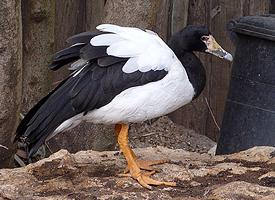
Známé také jako
- Husa stračí
- Husa strakatá
- Husovec stračí
Váhy a míry
| Výška v kohoutku | od 70 do 90 cm |
|---|---|
| Hmotnost | od 2 do 2,8 kg |
| Délka rozpětí křídel | od 125 do 180 cm |
Popis zvířete
The Magpie goose (Anseranas semipalmata) is a unique and intriguing species of waterfowl native to northern Australia and southern New Guinea. This distinctive bird is the sole member of the family Anseranatidae and genus Anseranas, setting it apart from other geese and ducks. The Magpie goose is not only remarkable for its taxonomic singularity but also for its striking appearance and fascinating behavior.Physical Description:
The Magpie goose is a large bird, with adults reaching lengths of up to 75-90 cm (30-35 inches) and weighing between 3 to 4 kg (6.6 to 8.8 lbs). It exhibits a somewhat pied appearance; its plumage is predominantly black and white, with the back, tail, and flight feathers being black, and the underparts and the head being mostly white. One of the most distinctive features of the Magpie goose is its knobbed bill, which is more prominent in males than in females. The species also has partially webbed feet, unlike the fully webbed feet seen in true geese, which is an adaptation to its semi-terrestrial lifestyle.
Habitat and Distribution:
Magpie geese are found in a variety of wetland habitats including floodplains, swamps, and billabongs in northern Australia, with a smaller population in southern New Guinea. They prefer areas with abundant aquatic vegetation, which forms a significant part of their diet. The distribution of the Magpie goose is largely influenced by the seasonal availability of suitable wetlands, and they are known to migrate within their range in response to the changing availability of water and food.
Diet:
The diet of the Magpie goose is primarily herbivorous, consisting mainly of aquatic plants, seeds, and grasses. They have a particular preference for the bulbs of the water lily and other aquatic and semi-aquatic vegetation. These geese are often seen foraging in shallow waters or on land near water bodies.
Behavior and Reproduction:
Magpie geese are highly social birds, often found in large flocks, especially during the breeding season. They are monogamous, forming long-term pair bonds, and are unique among waterfowl in that they often form trios consisting of one male and two females, all of which participate in raising the young. The breeding season is closely tied to the wet season when food resources are abundant. Nests are built on floating vegetation or in trees near water. Females lay between 5 to 14 eggs, which are incubated for about 23 to 30 days. Both parents, and sometimes a "helper" from a previous brood, care for the young, which are precocial and able to swim and feed themselves shortly after hatching.
Conservation Status:
Currently, the Magpie goose is classified as being of Least Concern by the International Union for Conservation of Nature (IUCN), thanks to its wide distribution and large, stable population. However, the species is not without threats; habitat destruction due to agricultural expansion, altered water regimes, and hunting in some areas could impact their numbers. Conservation efforts focusing on the protection of wetland habitats and sustainable water management are crucial for ensuring the continued survival of the Magpie goose.
In conclusion, the Magpie goose is a fascinating and distinctive species with unique biological and ecological traits. Its striking appearance, interesting social structure, and the critical role it plays in wetland ecosystems make it a subject of interest not only for ornithologists but also for conservationists aiming to preserve the rich biodiversity of Australia's and New Guinea's wetlands.
Nové fotografie zvířat
Top 10 zvířat
- Chinese water dragon (Physignathus cocincinus)
- Galápagos tortoise (Geochelone nigra complex)
- Dolphin gull (Leucophaeus scoresbii)
- Japanese macaque (Macaca fuscata)
- Colombian red howler (Alouatta seniculus)
- Sea urchins (Echinoidea)
- Diana monkey (Cercopithecus diana)
- Moustached guenon (Cercopithecus cephus)
- Common reed warbler (Acrocephalus scirpaceus)
- Common house mosquito (Culex pipiens)